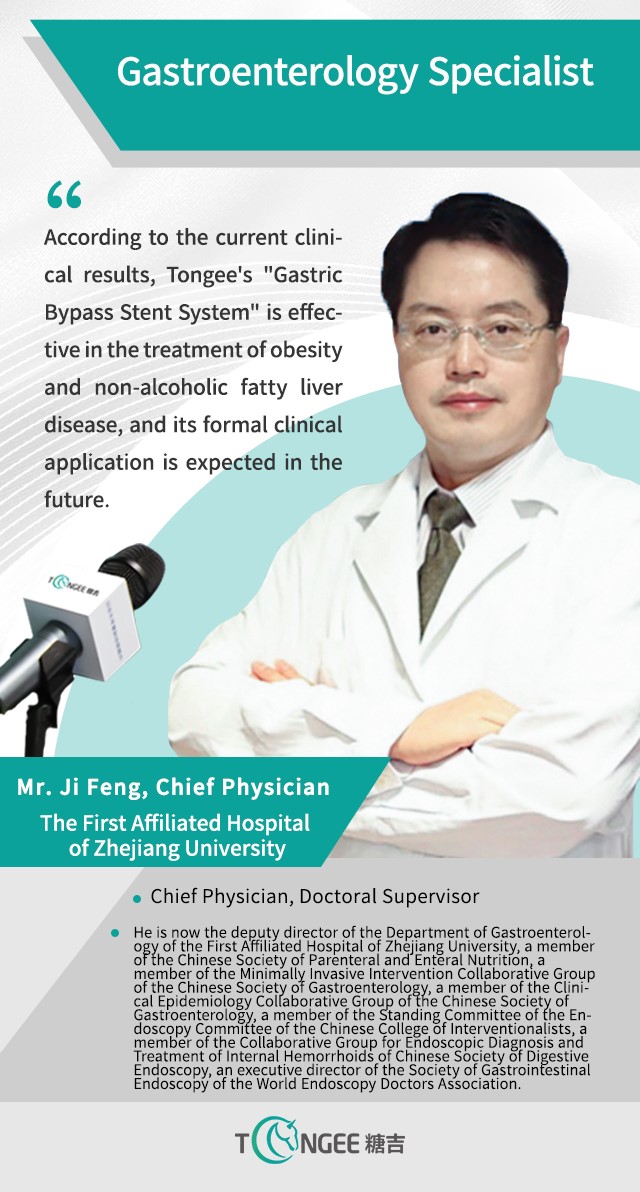The Current Clinical Results of Tongee's "Gastric Bypass Stent System" Show Good Effects on NAFLD in the View of Ji Feng of The First Affiliated Hospital of Zhejiang University
For many years, hepatitis B virus infection has been the number one culprit for the high incidence of liver cancer in China, but nowadays, fatty liver is becoming one of the major causative factors of liver cancer.
With regard to epidemiological statistics and analysis, the global prevalence of non-alcoholic fatty liver disease (NAFLD), the most common type of fatty liver, has reached about 25% and is still on the rise. In the past three decades, the prevalence in the United States has increased from 20% to 32%, and studies by Chinese scholars have also shown that the prevalence of NAFLD among adults in China is as high as 29.2%. 12
There is no doubt that the impact of fatty liver on human health should not be underestimated. However, what exactly are the health risks of this most common type of NAFLD? What are the scientific clinical treatment methods? Recently, we invited Mr. Ji Feng, Deputy Director of the Department of Gastroenterology of the First Affiliated Hospital of Zhejiang University, to participate in an interview, and we may find the answers to these questions in this interview.
The following is part of the interview (abridged without changing the original meaning), for the benefit of the audience:
Guest of this interview: Mr. Ji Feng
Chief Physician, Doctoral Supervisor
He is now the deputy director of the Department of Gastroenterology of the First Affiliated Hospital of Zhejiang University; a member of the Chinese Society of Parenteral and Enteral Nutrition, a member of the Minimally Invasive Intervention Collaborative Group of the Chinese Society of Gastroenterology, a member of the Clinical Epidemiology Collaborative Group of the Chinese Society of Gastroenterology, a member of the Standing Committee of the Endoscopy Committee of the Chinese College of Interventionalists, a member of the Collaborative Group for Endoscopic Diagnosis and Treatment of Internal Hemorrhoids of Chinese Society of Digestive Endoscopy, an executive director of the Society of Gastrointestinal Endoscopy of the World Endoscopy Doctors Association, a member of China Cancer Prevention and Treatment Committee, a member of the standing committee of Parenteral and Enteral Nutrition of Chinese Research Hospital Association, the former director of Zhejiang Parenteral and Enteral Nutrition Society, chairman-elect of Zhejiang Gastroenterology Society, the head of Zhejiang Endoscopic Diagnosis and Treatment Group of Esophagogastric Fundic Varices, the head of Zhejiang Enteral Nutrition Access Group; a member or a corresponding member of the editorial board of Hepatobiliary & Pancreatic Diseases International, Zhejiang University Science B, Chinese Journal of Gastroenterology, Chinese Journal of Digestive Endoscopy and many other journals.

Question 1: As an expert in gastroenterology, how do you view the health risks of non-alcoholic fatty liver disease?
Director Ji Feng: Non-alcoholic fatty liver disease (NAFLD) is the most common chronic liver disease in the world, and the prevalence of NAFLD in adults ranges from 6.3% to 45%, while the prevalence of NAFLD in China has been increasing year by year, reaching more than 25%.
In fact, mild fatty liver is reversible, but if fatty liver is completely ignored, irreversible fibrosis will occur within 10-15 years, which may pose great risks to people's health. In the past, many people suffered cirrhosis from hepatitis B virus, but now that hepatitis B has almost disappeared as the hepatitis B vaccine came out, most of the subsequent cirrhosis is caused by fatty liver. Some studies have shown that fatty liver disease (such as non-alcoholic fatty liver) can develop into liver cancer, so we must take it seriously.
Question 2: What are the current clinical pathways for the treatment of non-alcoholic fatty liver disease in general?
Director Ji Feng: There are several ways to treat fatty liver: one is by exercise and diet control, but this is difficult for many patients to practice; the second is by medication, but long-term oral medication can also damage the liver, and patients may suffer from side effects and expensive costs. In addition, the medication process itself is troublesome and requires strong compliance, requiring patients to take the medication every day; there is also another treatment method, namely, surgical treatment, such as to reroute the stomach and intestines with gastric bypass surgery. However, this method changes the physiological structure of the human body and is very traumatic, which is generally not accepted for patients.
In addition to the above solutions, endoscopic intervention in some new medical therapies are also being researched for weight control and treatment of fatty liver, and I believe that's a good way to go.
Question 3: We know that a new treatment for NAFLD by endoscopic intervention, "Gastric Bypass Stent System", is currently under clinical trial at the First Affiliated Hospital of Zhejiang University, and you are leading the trial. What do you think is the significance of this technology for the treatment of NAFLD? What is the feedback from the subjects on its effect and during the clinical placement?
Director Ji Feng: Currently, in our formal clinical practice, there is a gap in using endoscope for weight reduction and treatment of metabolic diseases, such as NAFLD. Featured by highly technical and usable characteristics, the "Gastric Bypass Stent System" and its good performance in the clinical trial stage give us hope that this gap will be filled, which is very encouraging.
Judging from the current clinical trials, Tongee's "Gastric Bypass Stent System" has been very effective in weight reduction and fatty liver treatment. Recently, one of our subjects lost about 12.5 kilograms after three months of stenting, and his fatty liver condition was reversed when the device was removed.
So I am relatively confident about the future clinical application of this technology.
Conclusion:
As Director Ji Feng said, non-alcoholic fatty liver disease, if not taken seriously, will pose a serious risk to human health, so the scientific diagnosis and treatment path for this disease deserves more attention and focus.
Nowadays, as science and technology keeps evolving, new medical tools such as the "Gastric Bypass Stent System" are emerging, bringing more hope for patients to be "reborn", and also pushing China's medical career and the "Health China 2030" strategy forward. We will continue to focus on the emerging medical technologies related to metabolic diseases, and expect our research-based innovative enterprises to continue to make efforts to bring more breakthroughs in China's health care field and help hundreds of millions of metabolic disease patients regain their health down the road.
The First Affiliated Hospital of Zhejiang University

The First Affiliated Hospital of Zhejiang University is a large grade A tertiary general hospital integrating medical treatment, teaching and scientific research, which is renowned at home and abroad for its strong comprehensive strength, excellent medical quality and distinctive disciplinary features; it is also the guidance center of medical, teaching and scientific research of Zhejiang Province. Since its establishment, the hospital has developed the mission of "promoting human health with excellent medical quality" and the vision of "becoming an international first-class medical center", and created the core values of "rigorous and realistic" and the development ideas of "creating a world-class medical center with rigorous education and training as the cornerstone, innovative scientific research as the leader, excellent medical technology as the guarantee, and first-class health services as the goal, relying on scientific and standardized management to realize the self-worth of employees.
1Zhou J, Zhou F, Wang W, Zhang XJ, Ji YX, Zhang P, She ZG, Zhu L, Cai J, Li H. Epidemiological Features of NAFLD From 1999 to 2018 in China. Hepatology. 2020 May;71(5):1851-1864.
2 Zhou F, Zhou J, Wang W, Zhang XJ, Ji YX, Zhang P, She ZG, Zhu L, Cai J, Li H. Unexpected Rapid Increase in the Burden of NAFLD in China From 2008 to 2018: A Systematic Review and Meta-Analysis. Hepatology.2019 Oct;70(4):1119-1133.
